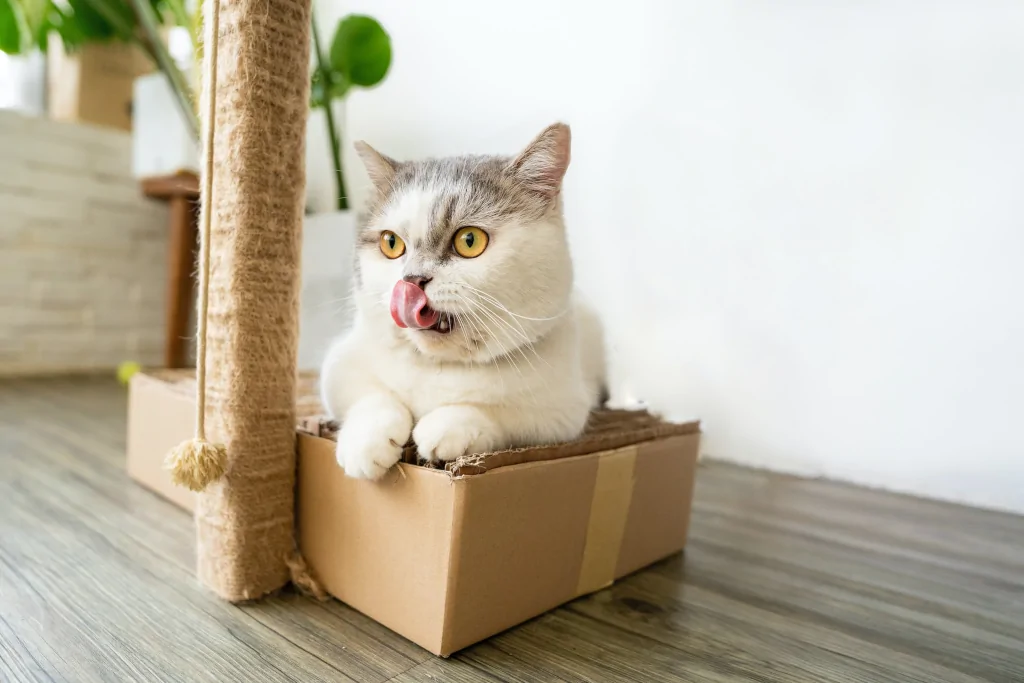Disclosure: We may earn a commission from helpful, relevant links in our content. No cost to you. See our privacy policy.
If you’ve ever found yourself scratching your head, wondering how to keep your feline friend mentally stimulated and happy, you’re in the right place.
Our furry companions, like Smokey, my playful tabby, thrive on an environment that challenges their senses and sharpens their natural instincts.
One time, I caught Smokey chasing his tail like a dog, which made me realize I needed to step up my game and provide him with better mental stimulation.
So, let’s dive into the world of cat mental health and enrichment, discovering ways to keep your cat purring with contentment.

Why Is Mental Health and Enrichment Essential for Cats?
Mental health and enrichment are crucial for cats because they play a significant role in their overall well-being.
Cats are intelligent and curious creatures, requiring mental stimulation to keep them engaged, happy, and healthy. Providing an enriched environment can prevent boredom, anxiety, and stress, which may lead to unwanted behaviors or health issues.
Moreover, mental health and enrichment foster a strong bond between you and your feline companion, creating a happy and harmonious relationship.
Enriching Your Cat’s Environment: Toys, Scratching Posts, and More
Creating an enriching environment for your cat is crucial to their mental well-being and overall happiness. By providing a variety of toys, scratching posts, and other stimulating items, you’ll encourage your cat to stay active, engaged, and content. Here are the best ways to enrich your cat’s environment.
Diversify Toys for Different Types of Play
To keep your cat entertained, provide a variety of toys that cater to different types of play.

Some popular options include puzzle toys like the Catit Food Maze, which challenges your cat’s cognitive skills, or battery-operated toys that encourage chasing and pouncing.

Feather wands, such as the GoCat Da Bird, are also a great choice for interactive playtime. Rotate the toys regularly to maintain your cat’s interest.
I remember when I bought Smokey a simple cardboard box, and he ended up playing with it for hours, proving that sometimes the most inexpensive items can bring the most joy.
Invest in a Quality Scratching Post
Scratching is a natural behavior for cats, as it helps maintain their claws and mark their territory. Provide your cat with a sturdy scratching post or pad made from materials like sisal or corrugated cardboard.

Some popular options include the SmartCat Ultimate Scratching Post and the PetFusion Jumbo Cat Scratcher Lounge.
Place the scratching post in a prominent area of your home, where your cat spends most of its time, to encourage its use.
Create Vertical Spaces for Climbing and Perching

Cats love to climb and perch in high places, as it gives them a sense of security and allows them to observe their surroundings. Incorporate cat trees, shelves, or window perches into your home to provide your feline friend with a variety of vertical spaces to explore.
Any one of the Frisco Cat Trees and the K&H Pet Products EZ Mount Window Bed are both excellent options to consider.

For my cat Smokey, I installed a series of wall-mounted shelves, which he uses as his personal playground and observation deck.
Stimulate the Senses with Cat-friendly Plants
Introduce cat-friendly plants to your home to stimulate your cat’s senses and provide an opportunity for safe exploration. Catnip, cat grass, and catmint are excellent choices that many cats enjoy.
You can find live plants, such as the Pet Greens Garden Self-Grow Catnip Kit or the Catit Senses 2.0 Grass Planter Kit, to add to your home.
Be sure to research and avoid toxic plants that can be harmful to your feline friend.
Hide Treats and Toys Around the House
Hide treats or toys in various locations throughout your home to encourage your cat’s natural hunting instincts. This activity can keep your cat mentally and physically engaged while providing a fun and rewarding experience.
Remember to switch up the hiding spots regularly to maintain the element of surprise.
Interactive Play: Bonding and Stimulating Your Cat’s Mind
Engaging in interactive play with your cat not only strengthens the bond between you both but also provides essential mental and physical stimulation. In this section, we’ll discuss various types of interactive play and offer tips to help you make the most of your playtime together.
Use Wand Toys for Engaging Play Sessions
Wand toys, such as feather teasers or toys with dangling objects, are excellent for interactive play. They allow you to simulate the movements of a prey animal and engage your cat’s natural hunting instincts.
By controlling the toy, you can adjust the speed and difficulty level of the game, keeping your cat entertained and challenged.
Incorporate Puzzle Toys for Mental Stimulation
Puzzle toys can be a great way to stimulate your cat’s mind while providing a reward for their efforts. There are various types of puzzle toys available, ranging from simple treat dispensers to more complex puzzles that require problem-solving skills.
Start with an easy toy and gradually increase the difficulty as your cat becomes more adept at solving them.
Play Hide and Seek with Your Cat
Engage in a game of hide and seek with your cat by hiding behind furniture or around corners and encouraging them to find you.
You can use a toy or a treat as a lure, or simply call their name and praise them when they locate you. This game not only stimulates your cat’s mind but also helps strengthen the bond between the two of you.
Train Your Cat to Perform Simple Tricks
Contrary to popular belief, cats can be trained to perform tricks, and doing so can be a great way to bond and challenge them mentally.
Start with simple commands like “sit” or “come” and gradually progress to more complex tricks like “high five” or “spin”. Use positive reinforcement, such as treats or praise, to reward your cat for their efforts.
Schedule Regular Play Sessions
Set aside time each day for interactive play with your cat.
Consistent play sessions help establish a routine and provide an opportunity for bonding and mental stimulation. Make sure to vary the type of play and toys used to keep your cat engaged and interested.
My cat Smokey and I have a special playtime ritual every evening, where we play various games using different toys – from chasing a laser pointer to batting around a crinkly ball. It’s a time we both look forward to each day, especially when Smokey does his signature somersault while chasing the laser.
How Socialization Affects Your Cat’s Mental Health
Socialization plays a critical role in your cat’s mental health and overall well-being. A well-socialized cat is more likely to be confident, adaptable, and less prone to stress and anxiety.
Early socialization, ideally during the critical kitten period (between 2 to 9 weeks of age), helps your cat become accustomed to various people, animals, and experiences. However, it’s never too late to work on socialization.
Expose your cat to new experiences gradually, ensuring they feel comfortable and secure at each stage. Positive reinforcement, like treats and praise, can help make these encounters more enjoyable.
Remember, every cat is unique. Some may be naturally more outgoing, while others may require more patience and time to adjust.
It’s also essential to monitor your cat’s interactions with other animals, especially if you have a multi-pet household. Encourage gentle play and positive interactions to prevent aggression and territorial issues.
Providing separate resources, such as food bowls, litter boxes, and sleeping areas, can reduce tension and contribute to a harmonious environment.

Mental Health Warning Signs: What to Watch For
Be on the lookout for these mental health warning signs in your cat:
- Changes in Appetite. A sudden increase or decrease in your cat’s food intake may signal stress or anxiety.
- Excessive Grooming. Over-grooming, leading to bald patches or skin irritation, can be a sign of stress or an underlying health issue.
- Hiding or Withdrawal. If your cat starts hiding more often or becomes less social, this may indicate a change in their mental well-being.
- Aggression or Fearfulness. Uncharacteristic aggression or fear towards people or other animals can be a sign of stress or anxiety.
- Elimination Outside the Litter Box. If your cat starts peeing or pooping outside their litter box, it may signal stress or an underlying health concern.
- Vocalization Changes. Increased or unusual vocalizations, such as excessive meowing or yowling, can be a sign of distress or discomfort.
- Destructive Behavior. Scratching furniture or other destructive behaviors may indicate boredom or anxiety.
If you notice any of these warning signs, consult with your veterinarian to rule out any medical issues and discuss potential solutions to improve your cat’s mental health.
Helping Your Cat Adjust to Changes and New Experiences
Helping your cat adjust to changes and new experiences is essential because sudden changes can be stressful for them, potentially leading to behavioral issues or a decline in their overall well-being.
Start by introducing changes gradually and maintaining a consistent routine. For example, when I first adopted Smokey, I made sure to introduce him to his new home slowly, allowing him to explore one room at a time. This helped Smokey feel more secure and in control of his environment.
Use positive reinforcement, like treats and praise, to create positive associations with new experiences. Ensure that your cat has access to familiar items, such as their bed, toys, and scratching posts, during transitions to provide comfort and stability
If your cat seems particularly stressed or anxious during a change, consult your veterinarian or a feline behavior specialist for personalized guidance and support.
By providing support and guidance during transitions, you can help your cat feel secure and confident, ultimately promoting a happier, healthier life.
FAQs
How much playtime should my cat have daily?
Cats typically need at least 15-30 minutes of interactive playtime daily, divided into multiple sessions.
Can I overstimulate my cat with too many toys?
While it’s unlikely, offering a variety of toys and rotating them regularly can prevent boredom and maintain interest.
How can I tell if my cat is bored or stressed?
Signs of boredom or stress include excessive grooming, changes in appetite, vocalization, hiding, or destructive behavior.
How can I encourage my cat to be more active?
Increase your cat’s activity levels by engaging in interactive play, providing climbing opportunities, and offering puzzle feeders or toys that stimulate their natural hunting instincts.
Alex, a passionate animal lover, has experience in training and understanding animal behavior. As a proud pet parent to two dogs and three cats, he founded AnimalReport.net to share insights from animal experts and expand his knowledge of the animal kingdom.




